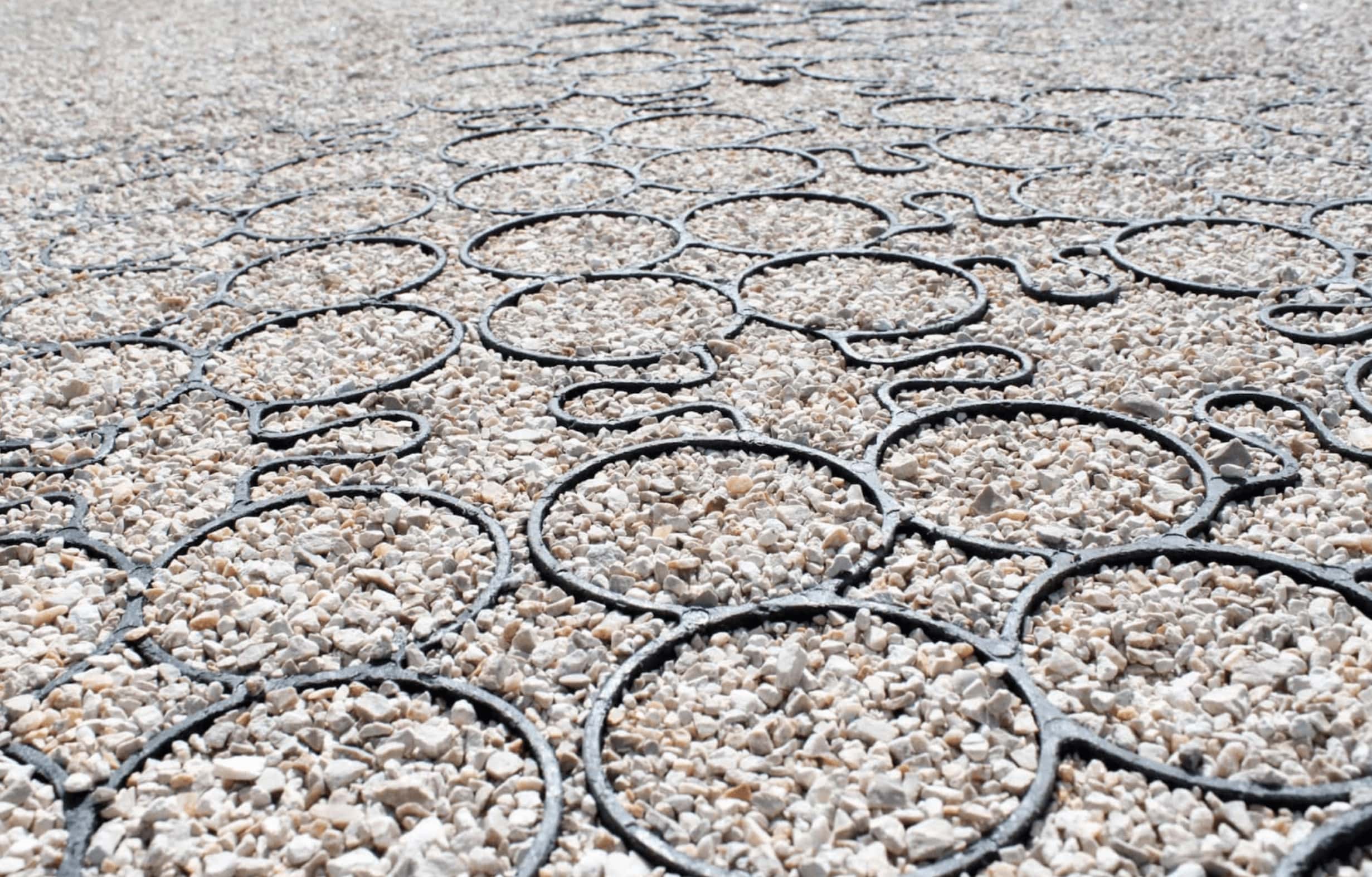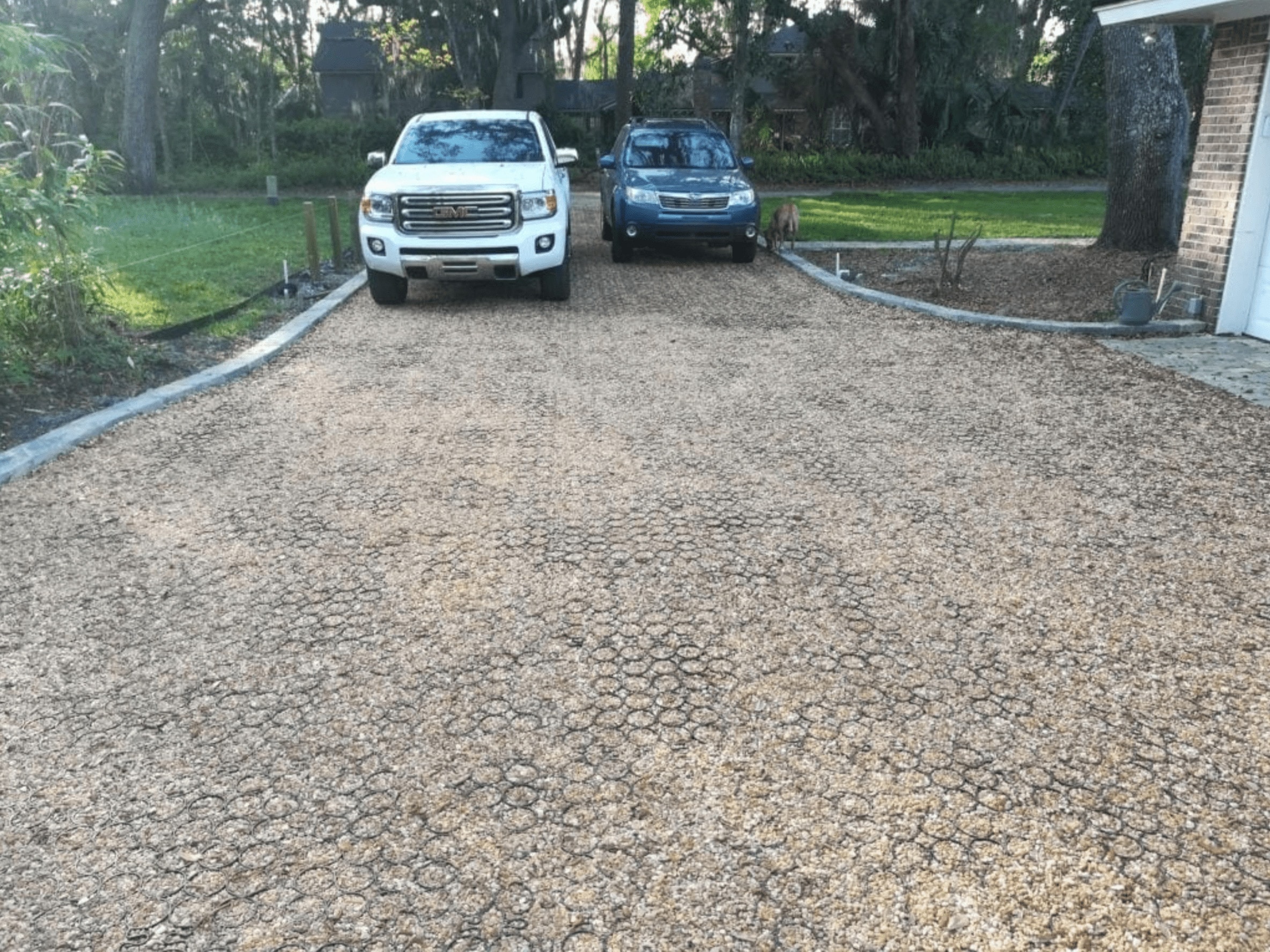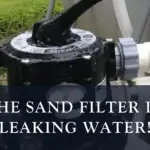Are you tired of navigating through a muddy driveway every time it rains? Muddy driveways not only make a mess of your car and shoes but can also pose safety hazards and diminish the curb appeal of your home.
You’re not alone in dealing with this soggy situation, and the good news is that you can transform that muddy mess into a solid, reliable surface. Imagine being able to drive up to your home without the worry of getting stuck or dragging mud into your house.
Whether you’re dealing with a few puddles or a full-blown swamp, this guide will walk you through simple, effective steps to fix your muddy driveway and keep it in tip-top shape. Get ready to take control of your driveway and make it a clean, dry, and welcoming entrance to your home.
Assessing The Situation
A muddy driveway poses challenges for homeowners. Fixing it starts with understanding the issues. Assessing the situation helps pinpoint areas needing attention. This is crucial for effective solutions.
Identifying Problem Areas
Walk the length of your driveway. Notice where water accumulates. Check for spots that stay wet longer. Look for areas where mud is thicker. These are the problem areas. Mark them for reference.
Evaluating Severity Of Mud
Examine the depth of the mud. Is it shallow or deep? Feel the texture. Is it sticky or loose? Consider how your car struggles on it. Note if mud covers your shoes. Severe mud needs urgent action.

Credit: www.truegridpaver.com
Choosing The Right Materials
Choosing the right materials for your muddy driveway can be the difference between a temporary fix and a long-lasting solution. You’ll need materials that not only improve the driveway’s appearance but also enhance its functionality. Considering factors like durability, cost, and environmental impact is crucial. Let’s dive into the options available and see which ones might suit your needs best.
Gravel And Stone Options
Gravel and stones are popular choices for fixing muddy driveways. They provide excellent drainage and a firm surface. Have you ever noticed how some driveways seem to withstand heavy rains while others become a mud pit? The secret often lies in the type of gravel or stone used.
Opt for crushed stone or pea gravel. They interlock well, creating a stable base. Crushed stone is angular, which helps it stay put. Pea gravel is smaller and rounder, making it a good top layer. Consider the color too; it can add a beautiful touch to your home’s exterior.
Think about the maintenance required. Gravel tends to shift over time, especially with vehicle traffic. Regular raking can help maintain an even surface. Is this something you’re ready to commit to?
Soil Stabilizers
Soil stabilizers are a game changer for muddy driveways. They bind the soil particles together, creating a solid, impermeable surface. Have you ever wondered why some rural roads are practically mud-free? Often, soil stabilizers play a key role.
These products come in liquid form and are mixed with the existing soil. You’ll need to assess your driveway’s specific soil type to choose the right stabilizer. Are you dealing with clay, silt, or sand? Different stabilizers work better with different soils.
One benefit is reduced environmental impact. Stabilizers often use natural ingredients, making them a greener choice. They also minimize erosion, keeping your driveway intact longer. Would an eco-friendly option appeal to you?
Choosing the right materials is about finding balance between aesthetics, functionality, and maintenance. Which option resonates with your needs and lifestyle?
Drainage Solutions
Dealing with a muddy driveway can be frustrating. Effective drainage solutions can help. Proper drainage ensures your driveway stays dry and usable. Addressing drainage issues improves water flow and reduces mud accumulation. Two key methods for enhancing drainage include French drains and surface drainage improvement.
Installing French Drains
French drains are a popular choice for managing water. They direct excess water away from your driveway. To install, dig a trench on the side of the driveway. Place a perforated pipe inside. Cover the pipe with gravel. This setup allows water to flow through the pipe. It prevents water from pooling on your driveway.
French drains are effective in areas with heavy rainfall. They require little maintenance. Regularly check for blockages to ensure proper function. French drains can extend the life of your driveway.
Improving Surface Drainage
Surface drainage involves reshaping the driveway surface. This helps water flow away naturally. Grade the driveway to create a slight slope. This slope channels water off the surface. Avoid flat areas where water can pool.
Consider adding gravel to improve drainage. Gravel allows water to seep into the ground. It reduces surface water accumulation. Regular maintenance keeps the driveway in good condition. Clear debris to prevent water blockage. Surface drainage improvement enhances the driveway’s usability.

Credit: www.truegridpaver.com
Surface Preparation
Fixing a muddy driveway starts with proper surface preparation. Ensure the area is clear of debris and level the ground. Applying gravel or crushed stone provides a stable surface, reducing mud and improving drainage.
Preparing the surface of your muddy driveway is a crucial step in ensuring a durable and long-lasting fix. This process might seem straightforward, but it sets the foundation for everything that follows. Proper preparation not only enhances the effectiveness of the materials used but also minimizes future maintenance.Clearing Debris
Start by removing any debris like fallen leaves, rocks, or loose sticks from your driveway. These items can create uneven surfaces and interfere with the leveling process. Use a sturdy rake or a leaf blower to clear the area thoroughly. It’s important to ensure that all organic matter is removed. Leftover debris can decompose and lead to further sinking and unevenness in the future. This step may seem trivial, but it’s a game-changer for a smooth finish.Leveling The Driveway
Once the debris is cleared, focus on leveling the driveway. Uneven surfaces can cause water to pool, leading to more mud and erosion. Use a shovel or a hoe to fill in any low spots with gravel or crushed stone. You might find it helpful to rent a small compactor for larger areas. Compacting the gravel ensures a solid base that can withstand weather changes and heavy vehicles. Have you ever noticed how water tends to find the path of least resistance? Leveling prevents this by creating a consistent surface for drainage. By taking these simple but effective steps, you’re not just fixing a muddy driveway; you’re setting the stage for a resilient and stable pathway. So, are you ready to transform that muddy mess into a smooth, reliable driveway?Applying Gravel And Stone
Transform a muddy driveway by applying gravel and stone. This solution creates a stable surface and improves drainage. Enjoy a cleaner, smoother path to your home.
Applying gravel and stone to your muddy driveway can be a game-changer. It not only improves the aesthetics but also enhances functionality by providing a solid surface. By following effective techniques, you can transform that quagmire into a reliable entryway.Layering Techniques
Begin with a base layer of larger stones. This foundational layer helps with drainage and prevents the surface from sinking. A common choice is crushed stone, which allows water to pass through easily. Next, add a middle layer of medium-sized gravel. This layer ensures stability and provides a transitional cushion between the base and the top. It’s crucial to spread the gravel evenly to avoid uneven surfaces. Finally, cover it with a top layer of smaller gravel or crushed stone. This layer provides a smooth finish and makes it comfortable to drive on. Consider using decorative stone if you want to enhance the visual appeal.Compaction Methods
Proper compaction is key to a long-lasting driveway. You can rent a plate compactor from a local hardware store if you don’t have one. Compaction helps bind the layers, preventing the stones from shifting. Start compacting from the edge and work your way inward. This technique ensures that the edges are well-supported, reducing the risk of them crumbling away. Think of it as giving your driveway a sturdy frame. Don’t rush the process. Compaction is not just about walking the machine over the surface a few times. Make sure every section feels firm underfoot before moving on to the next. Have you ever walked on an uneven driveway and felt the stones giving way beneath your feet? Proper layering and compaction can prevent this. Take your time to do it right, and you’ll have a driveway that serves you well for years to come.Maintaining Your Driveway
Fixing a muddy driveway involves adding gravel for better drainage. Ensure proper grading to prevent water pooling. Regular maintenance keeps it sturdy and clean.
Maintaining Your Driveway Maintaining your driveway is essential to avoid the headache of dealing with mud and water pooling. A well-kept driveway isn’t just about aesthetics; it’s about functionality and convenience. Ensuring your driveway remains in good condition requires consistent attention and care.Regular Inspection
Inspect your driveway regularly. Check for cracks, potholes, and drainage issues. These small problems can turn into bigger issues if not addressed promptly. Walk around your driveway every few weeks. Look for signs of wear and tear. Catching problems early saves you time and money in the long run. Consider your driveway a part of your home maintenance routine. Just like you check your roof or plumbing, your driveway deserves the same attention.Seasonal Adjustments
Each season brings its own challenges. In spring, melting snow can lead to excess moisture. Make sure your driveway can handle it. During summer, heat can cause materials to expand and crack. Keep an eye out for any changes. Autumn leaves can block drainage paths. Regularly clear them to avoid water accumulation. In winter, the freeze-thaw cycle can be damaging. Use salt or sand wisely to manage ice without harming the surface. Have you noticed how some of your neighbors’ driveways seem to withstand the test of time? It often comes down to how they handle these seasonal changes. Maintaining your driveway is a proactive task. The more you pay attention to it, the longer it will last. What steps will you take to ensure your driveway stays in top shape?Preventing Future Issues
Tackling a muddy driveway involves proper drainage and gravel application. Regular maintenance prevents future issues by ensuring stable ground. Incorporating a layer of crushed stone can help manage water and improve durability.
Preventing future issues with your driveway is not just about fixing the existing mud problem. It’s about ensuring the solution lasts through the seasons. Imagine a driveway that stands strong in the face of rain and snow, staying firm and clean. This is entirely possible with a few proactive steps. Let’s delve into some practical measures you can take to prevent your driveway from becoming a muddy mess again.Planting Grass And Shrubs
One effective way to tackle driveway erosion is by planting grass and shrubs. These plants act as a natural barrier, keeping soil in place and absorbing excess water. Choose native plants, as they adapt better to the local climate and require less maintenance. You might be surprised by how much charm a few well-placed shrubs can add to your home’s curb appeal. Have you ever noticed how grass seems to hold onto the soil, even during heavy rains? That’s because the roots create a network that stabilizes the ground. Consider planting grass along the edges of your driveway, especially in areas prone to erosion. Not only does this help with drainage, but it also enhances the aesthetic appeal of your driveway.Using Geotextiles
Geotextiles are a game-changer for stabilizing driveways. These permeable fabrics allow water to pass through while preventing soil from mixing with the gravel or stone base. Installing geotextiles can significantly increase the lifespan of your driveway, making it a worthwhile investment. Picture a clean, durable surface that withstands the test of time. To install geotextiles, begin by clearing the driveway surface of debris. Lay the fabric evenly, ensuring it covers all areas you wish to stabilize. Then, add your gravel or stone base over it. This method creates a stable foundation that reduces maintenance needs. Have you ever wondered why some roads last longer than others? Geotextiles are often the hidden secret behind their durability. By adding this layer of protection, you minimize the risk of future muddy patches, saving you time and effort. Taking these preventive steps can transform your driveway into a reliable, low-maintenance feature of your home. What step will you take today to ensure your driveway remains mud-free for years to come?
Credit: www.youtube.com
Expert Advice
Tackling a muddy driveway can be challenging. Expert advice can make it easier. Professionals share insights to avoid common pitfalls and ensure longevity. This guidance helps in choosing effective solutions. Whether it’s gravel or drainage, understanding the basics is key. Explore common mistakes and long-term tips for success.
Common Mistakes To Avoid
Using the wrong materials is a frequent error. Not all gravel types suit driveways. Choose coarse gravel for better drainage. Another mistake is neglecting a solid base. A weak foundation results in future problems. Skipping drainage solutions is also risky. Proper drainage prevents water buildup. This avoids further muddiness.
Tips For Long-term Solutions
Regular maintenance extends the driveway’s life. Rake gravel to keep it even. Fill in low spots to prevent water pooling. Consider installing a geotextile fabric. It stabilizes the ground and enhances durability. Adding a layer of crushed stone improves drainage. It also strengthens the driveway surface.
Ensure your driveway slopes away from structures. This directs water runoff effectively. Using permeable pavers is another option. They allow water to pass through, reducing surface water. These tips help maintain a sturdy, mud-free driveway.
Frequently Asked Questions
What Are Common Causes Of A Muddy Driveway?
Poor drainage, heavy rain, and soil type can cause a muddy driveway. These issues lead to water accumulation.
How Can I Improve Driveway Drainage?
Install a French drain or gravel. These options help manage water flow and reduce mud problems effectively.
Is Gravel A Good Solution For Mud?
Yes, gravel improves traction and drainage. It prevents water buildup and keeps your driveway firm and stable.
Can I Use Sand To Fix A Muddy Driveway?
Sand isn’t ideal. It absorbs water and can worsen mud. Opt for gravel or crushed stone instead.
How Often Should I Maintain My Driveway?
Regular maintenance is key. Check and address issues every few months to keep your driveway in good condition.
Conclusion
Fixing a muddy driveway can seem overwhelming at first. But it’s doable with some effort and planning. Start by assessing the driveway’s drainage issues. Use gravel or pavers to improve stability and drainage. Regular maintenance helps keep the driveway in good condition.
Remember, a well-maintained driveway boosts your home’s appearance. Plus, it provides a safer path for vehicles and people. With these tips, you can tackle the mud and enjoy a cleaner driveway. A bit of work now saves trouble later. Enjoy your mud-free driveway!




